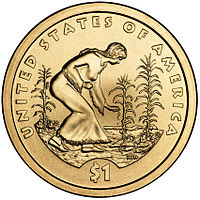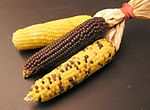Three Sisters (agriculture)

The Three Sisters are the three main agricultural crops of various Indigenous peoples of North America: winter squash, maize (corn), and climbing beans (typically tepary beans or common beans). Originating in Mesoamerica, these three crops were carried northward, up the river valleys over generations, far afield to the Mandan and Iroquois who, among others, used these Three Sisters for food and trade.
Cultivation methods[]
In a technique known as companion planting, maize (Zea mays), beans (Phaseolus sp.), and squash (Cucurbita pepo) are planted close together. The maize and beans are often planted together in mounds formed by hilling soil around the base of the plants each year; squash is typically planted between the mounds.[2] In the northeastern U.S., this practice increases soil temperature in the mound and improves drainage, both of which benefit maize planted in spring.[2] In Haudenosaunee (Iroquois) farming, the fields were not tilled, enhancing soil fertility and the sustainability of the cropping system by limiting soil erosion and oxidation of soil organic matter.[3]
The three crops benefit by being grown together.[2] The cornstalk serves as a trellis for the beans to climb, the beans fix nitrogen in the soil and their twining vines stabilize the maize in high winds, and the wide leaves of the squash plant shade the ground, keeping the soil moist and helping prevent the establishment of weeds.[4][5] The prickly hairs of some squash varieties also deter pests such as deer and raccoons.[5] Each mound is about 30 cm (12 in) high and 50 cm (20 in) wide, and several maize seeds are planted close together in the center of each mound; in parts of the Atlantic Northeast, rotten fish or eels are buried in the mound with the maize seeds, to act as additional fertilizer where the soil is poor.[citation needed]
Indigenous peoples throughout North America cultivated different varieties of the Three Sisters adapted to varying local environments.[6] The milpas of Mesoamerica are farms or gardens that employ companion planting on a larger scale.[7] The Ancestral Puebloans adopted this garden design in the drier deserts and xeric shrublands environment. The Tewa and other peoples of the North American Southwest often included a "fourth Sister", Rocky Mountain bee plant (Cleome serrulata), which attracts bees to help pollinate the beans and squash.[8][better source needed]
Productivity[]
European records from the sixteenth century describe highly productive Indigenous agriculture based on cultivation of the Three Sisters throughout what is now the Eastern United States, from Florida to Ontario.[3] Geographer Carl O. Sauer described the Three Sisters as "a symbiotic plant complex of North and Central America without an equal elsewhere".[9] Agronomist Jane Mt. Pleasant writes that the Three Sisters mound system "enhances the soil physical and biochemical environment, minimizes soil erosion, improves soil tilth, manages plant population and spacing, provides for plant nutrients in appropriate quantities, and at the time needed, and controls weeds".[2]
Nutritionally, maize, beans, and squash contain all nine essential amino acids[3] as well as complex carbohydrates and essential fatty acids.[citation needed] According to Mt. Pleasant, the protein from maize is further enhanced by protein contributions from beans and pumpkin seeds, while pumpkin flesh provides large amounts of vitamin A; with the Three Sisters, farmers harvest about the same amount of energy as from maize monoculture, but get more protein yield from the inter-planted bean and pumpkin. Mt. Pleasant writes that this largely explains the value of the Three Sisters over monoculture cropping, as the system yields large amounts of energy and at the same time increases protein yields; this polyculture cropping system yielded more food and supported more people per hectare compared to monocultures of the individual crops or mixtures of monocultures.[3]
Society and culture[]
Maize, beans, and squash, whether grown individually or together, have a very long history in the Americas.[3] The process to develop this agricultural knowledge took place over 5,000–6,500 years. Squash was domesticated first, with maize second and then beans being domesticated.[10][11] Squash was first domesticated 8,000–10,000 years ago.[12][13]
Cahokian, Mississippian and Mvskoke culture[]
This section does not cite any sources. (August 2021) |
Corn, squash and beans were planted ca. 800 AD in the largest Native American city north of the Rio Grande known as Cahokia, in the present US state of Illinois, across the Mississippi River from St. Louis, Missouri. The Three Sisters crops were responsible for the surplus food that created an expanded population throughout the extended Mississippi River System, creating the Mississippian and Mvskoke cultures that flourished from ca. 800 ce to ca. 1600 when physical contact with Spanish explorers brought Eurasian diseases, death, and cultural collapse.
Haudenosaunee culture[]
In the Handbook of North American Indians, the Three Sisters are called the "foundation of (Iroquois) subsistence", allowing the Haudenosaunee or Iroquois to "develop the institutions of sedentary life".[14] The Three Sisters appear prominently in Haudenosaunee oral traditions and ceremonies, such as the creation story and the thanksgiving address.[2] Researchers in the early 20th century described more than a dozen varieties of maize and similar numbers of bean varieties, as well as many types of squash, such as pumpkin and winter squash, grown in Haudenosaunee communities. The first academic description of the Three Sisters cropping system in 1910 reported that the Iroquois preferred to plant the three crops together, since it took less time and effort than planting them individually, and because they believed the plants were "guarded by three inseparable spirits and would not thrive apart".[3]
Among the Haudenosaunee, women were responsible for cultivation and distribution of the three crops, which raised their social status. Male roles traditionally included extended periods of travel, such as for hunting expeditions, diplomatic missions, or military raids. Men took part in the initial preparation for the planting of the Three Sisters by clearing the planting ground, after which groups of related women, working communally, performed the planting, weeding, and harvesting.[15] Based on archaeological findings, paleobotanist concludes that the Haudenosaunee began growing the three crops as a polyculture sometime after 700 BP.[3] Jane Mt. Pleasant writes that the Haudenosaunee frequently traded their crops, so the need for each crop could vary substantially from year to year. She surmises that the Haudenosaunee may have typically inter-planted the three crops, but they could also have planted monocultures of the individual crops to meet specific needs.[3]
Maya culture[]
The Maya diet focused on three domesticated staple crops: maize, squash, and beans (typically Phaseolus vulgaris). Among the three, maize was the central component of the diet of the ancient Maya and figured prominently in Maya mythology and ideology. Archaeological evidence suggests that Chapalote-Nal-Tel was the dominant maize species, though it is likely others were being exploited also.[16] Maize was used and eaten in a variety of ways, but was always nixtamalized.
Gallery[]

Maize

Common bean (Phaseolus vulgaris)

An assortment of winter squashes
See also[]
- Agriculture in the prehistoric Southwest
- Agroforestry
- Crop rotation
- Eastern Agricultural Complex
- Intercropping
- Mesoamerican agriculture
- Multiple cropping
- No-till farming
- Southern New England Algonquian cuisine
References[]
- ^ "2009 Native American $1 Coin". United States Mint. Retrieved September 18, 2013.
- ^ Jump up to: a b c d e Mt. Pleasant, Jane (2006). "The science behind the Three Sisters mound system: An agronomic assessment of an indigenous agricultural system in the northeast". In Staller, John E.; Tykot, Robert H.; Benz, Bruce F. (eds.). Histories of Maize: Multidisciplinary Approaches to the Prehistory, Linguistics, Biogeography, Domestication, and Evolution of Maize. Amsterdam: Academic Press. pp. 529–537. ISBN 978-0-1236-9364-8.
- ^ Jump up to: a b c d e f g h Mt. Pleasant, Jane (2016). "Food Yields and Nutrient Analyses of the Three Sisters: A Haudenosaunee Cropping System". Ethnobiology Letters. 7 (1): 87–98. doi:10.14237/ebl.7.1.2016.721. ISSN 2159-8126. JSTOR 26423653.
- ^ Young, Kim J. (2007). Hopkins, William G. (ed.). Ethnobotany. The Green World. New York: Infobase Publishing. pp. 57–58. ISBN 978-1-4381-0694-6.
- ^ Jump up to: a b Hill, Christina Gish (November 20, 2020). "Returning the 'three sisters' – corn, beans and squash – to Native American farms nourishes people, land and cultures". The Conversation. Retrieved January 8, 2021.
- ^ Sauer, Carl O. (1969). Agricultural origins and dispersals: the domestication of animals and foodstuffs (2nd ed.). Cambridge, Mass.: M.I.T. Press. pp. 64–66. OCLC 3917.
- ^ Mann, Charles (2005). 1491: New Revelations of the Americas Before Columbus. New York: Vintage Books. pp. 220–221. ISBN 978-1-4000-3205-1.
- ^ Hemenway, Toby (2000). Gaia's Garden: A Guide to Home-Scale Permaculture. White River Junction, Vt.: Chelsea Green Publishing. p. 149. ISBN 978-1-890132-52-1.
- ^ Sauer, Carl O. (1952). Agricultural origins and dispersals (1st ed.). Cambridge, Mass.: M.I.T. Press. p. 64. OCLC 1086141375. Cited in Mt. Pleasant (2016), p. 87.
- ^ Landon, Amanda J. (2008). "The 'How' of the Three Sisters: The Origins of Agriculture in Mesoamerica and the Human Niche". Nebraska Anthropologist. 23: 110–124. ISSN 1555-4937.
- ^ Bushnell, G. H. S. (1976). "The Beginning and Growth of Agriculture in Mexico". Philosophical Transactions of the Royal Society of London. London: Royal Society of London. 275 (936): 117–120. doi:10.1098/rstb.1976.0074.
- ^ Smith, Bruce D. (May 1997). "The Initial Domestication of Cucurbita pepo in the Americas 10,000 Years Ago". Science. Washington, DC: American Association for the Advancement of Science. 276 (5314): 932–934. doi:10.1126/science.276.5314.932.
- ^ "Cucurbitaceae--Fruits for Peons, Pilgrims, and Pharaohs". University of California at Los Angeles. Archived from the original on October 16, 2013. Retrieved September 2, 2013.
- ^ Fenton, William N. (1978). "Northern Iroquois Culture Patterns". In Trigger, Bruce G. (ed.). Handbook of North American Indians, Volume 15: Northeast. Washington, D.C.: Smithsonian Institution. p. 299. ISBN 978-0-1600-4575-2. Cited in Mt. Pleasant (2016), p. 87.
- ^ Bilharz, Joy (2002). The Allegany Senecas and Kinzua Dam: forced relocation through two generations. University of Nebraska Press. p. 8. ISBN 978-0-8032-6203-4.
- ^ Benz, Bruce F. (1986). Taxonomy and Evolution of Mexican Maize (doctoral thesis). University of Wisconsin, Madison. OCLC 17291438.
Further reading[]
- Boeckmann, Catherine (May 14, 2020). "The Three Sisters: Corn, Beans, and Squash: How to Plant a Three Sisters Garden". The Old Farmer's Almanac.
- Cornelius, Carol (1999). Iroquois Corn in a Culture-Based Curriculum: A Framework for Respectfully Teaching about Cultures. State University of New York Press. ISBN 978-0-7914-4027-8.
- Maxi'diwiac (Buffalo Bird Woman) (2008) [originally published 1917]. Wilson, Gilbert (ed.). Agriculture of the Hidatsa Indians: An Indian Interpretation. Gloucestershire: Dodo Press. p. 25. ISBN 978-1-4099-4233-7.
- Mt. Pleasant, Jane (2001). "The Three Sisters: Care for the Land and the People". In James, Keith (ed.). Science and Native American Communities: Legacies of Pain, Visions of Promise. University of Nebraska Press. pp. 126–134. ISBN 978-0-8032-7615-4.
- Postma, Johannes A.; Lynch, Jonathan P. (2012). "Complementarity in root architecture for nutrient uptake in ancient maize/bean and maize/bean/squash polycultures". Annals of Botany. 110 (2): 521–534. doi:10.1093/aob/mcs082. PMC 3394648. PMID 22523423.
- "The Three Sisters". American Farm Bureau Foundation for Agriculture. November 8, 2016.
- Vivian, John. "The Three Sisters: Corn, Beans and Squash". Mother Earth News.
External links[]
- Virtual Museum of Canada, The St. Lawrence Iroquoians — virtual exhibit that includes information on Iroquoian agriculture and the Three Sisters
- Plants used in Native American cuisine
- Crops originating from the United States
- Indigenous cuisine in Canada
- History of agriculture in the United States
- Organic gardening
- Permaculture
- Early agriculture in Mesoamerica
- Seneca people
- Iroquois
- Maize




